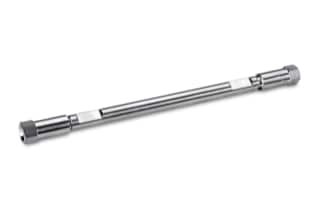
|
Chemistry |
C18 |
|
Separation Mode |
Reversed Phase |
|
Particle Substrate |
Silica |
|
pH Range Min |
2 pH |
|
pH Range Max |
8 pH |
|
Temperature Limits |
45 C |
|
Maximum Pressure |
6000 psi (415 Bar) |
|
Endcapped |
Yes |
|
Bonding Technology |
T3 |
|
Silanol Activity |
Medium |
|
Particle Shape |
Spherical |
|
Particle Size |
3.5 µm |
|
Endfitting Type |
Waters |
|
Pore Size |
100 Å |
|
Format |
Column |
|
Surface Area |
230 |
|
System |
HPLC |
|
Particle Technology |
HSS |
|
USP Classification |
L1 |
|
Inner Diameter |
2.1 mm |
|
Length |
100 mm |
|
Carbon Load |
11 % |
|
UNSPSC |
41115709 |
|
Brand |
XSelect |
|
Product Type |
Columns |
|
Units per Package |
1 pk |

XSelect HSS T3 Column, 100Å, 3.5 µm, 2.1 mm X 100 mm, 1/pk
The trifunctional alkyl C18 bonded phase used for the HSS T3 sorbents is compatible with 100% aqueous mobile phase and provides ultra-low MS bleed while promoting superior polar compound retention. HSS T3 HPLC columns are fully scalable and transferable to UPLC separations.
The XSelect HSS T3 Column is based on HSS (High Strength Silica) Technology which has been developed by Waters to complement the chromatographic performance of BEH (Ethylene Bridged Hybrid) and CSH (Charged Surface Hybrid) particles. The embedded HSS technology in the XSelect HSS T3 Column enables the column to have higher silanophilicity; this assists the column by providing it with increased polar compound retention and significantly different selectivity that you will observe in your analysis. The High Strength Silica (HSS) technology has been developed to carry the mechanical strength necessary to work with the UPLC pressures, making the columns quite robust.
The XSelect HSS T3 Column provides high transferability and excellent reproducibility. The lab equipment possesses the chemical and physical characteristics for seamless scalability, making the XSelect HSS T3 Column a unique asset for your laboratory. With its select features, the XSelect HSS T3 Column will provide you with higher resolution separations that are required for complex samples in order to isolate and quantify the sample constituents. You will be able to achieve high resolution of even very complex samples with the efficiency and selectivity of the XSelect HSS T3 Column.
The right lab equipment will assist you in increasing your laboratory productivity. If you are interested in reviewing additional offerings of Waters that are compatible with the XSelect HSS T3 Column, or additional products that you might be interested in, we recommend shopping for lab equipment by browsing through our website or referring to our catalog and ensure your lab needs are met as needed.
You may also want to look into our Reversed-Phase QC Reference Material; it is a unique collection of standards and mixtures. Specifically designed to provide this complexity and is appropriate when complex assays are routinely performed. It can be used with a variety of column chemistries, dimensions, and system hardware. It contains 7 compounds, including uracil, butylparaben, naphthalene, propranolol, dipropyl-phthalate, acenaphthene, and amitriptyline at pH 7.
How Important Is Resolution In Chromatography?
Within laboratory experiments conducted, the resolution is a function of peak width and retention time, both of which are inherent properties of the chromatographic process; the resolution is extremely important as the measurements can be used for optimizing separations.